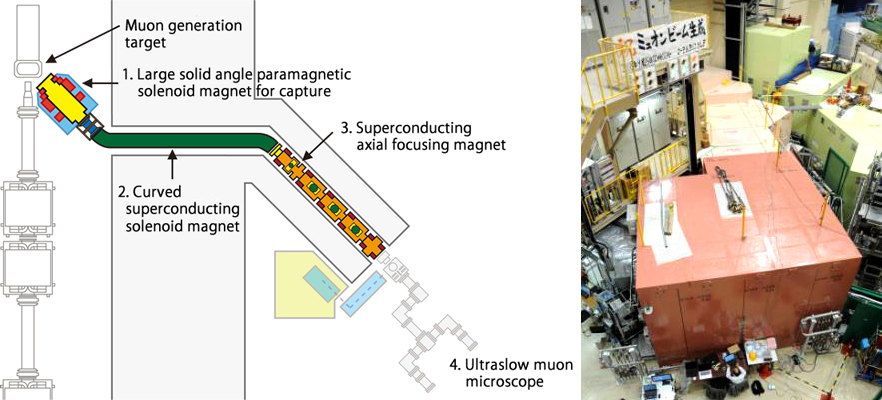Press Release
Achievement of the world’s strongest pulsed muon beam
November 27, 2012
High Energy Accelerator Research Organization (KEK)
J-PARC Center
The MUSE group at the Institute of Materials Structure Science, KEK, succeeded in extracting the world’s strongest pulsed muon beam, 2,500,000 muons per pulse (proton beam intensity of 212 kW) to the U1 experimental area at the Materials and Life Science Experimental Facility (MLF) at the Japan Proton Accelerator Research Complex (J-PARC). This intensity achieved at the U-line exceeds the previous intensities, 72,000 muons per pulse (120kW) and 180,000 muons per pulse (300 kW), which were both achieved at the D-line of this facility in 2010, respectively, as well as intensities presently available at any other pulsed muon facilities globally thus far. It means that a new world record was established. The achieved intensity not only shortens the measurement time to one-twentieth compared with present measurements, but also may open a new era to capture novel information that could not be recognized before.
The MUSE group has been developing an axial focusing muon transport system to capture and transport muons efficiently, in collaboration with the cryogenic section at J-PARC. This system consists of a large acceptance solenoid made of mineral insulation cables (MIC), a superconducting curved transport solenoid magnet and a superconducting axial focusing magnet system. There, we can collect muons with a large acceptance of 400 mSr. Compared to conventional beamlines such as the D-line, the large acceptance of the front-end solenoid allows for the capture of more than 10 times higher pulsed muon intensity.
As a next step, we are planning to stop such intense pulsed muons into a hot tungsten target for generating intense ultra-slow muon beams in order to realize the “ultraslow muon microscope” that will enable not only for a wide variety of surface and nano-science studies, but also novel 3D imaging. It will also be employed in the fundamental physics research, for instance, in the precise measurement of the hyperfine splitting of muonium, which implies the existence of new physics laws beyond the Standard Model, or the precise measurement of the anomalous magnetic moment (g-2) of muons.
【Results】
Comparison of the number of muons per pulse
Facility |
Number of muons per pulse |
Proton beam power |
|
J-PARC/MLF |
2,500,000 |
212 kW |
Nov. 2012 |
J-PARC/MLF |
72,000 |
120 kW |
Mar. 2010 |
Rutherford Appleton Laboratory (U.K.) |
30,000 |
160 kW |
|
【Reference figure】

Fig.1 Schematic and overview of the U-line that achieved the world’s strongest pulsed muon beam.

Fig.2 Left; Curved superconducting solenoid electromagnet Right; Superconducting axial focusing electromagnet
Media Contact
[ for public relations ]
Shinichi Sakamoto
Leader, Public Relations Section, J-PARC Center, Japan
TEL: +81-29-284-3587
FAX: +81-29-284-5996
E-mail: sakamoto.shinichi@jaea.go.jp
Saeko Okada
Public Relations Office, High Energy Accelerator Research Organization (KEK), Japan
TEL: +81-29-879-6047
FAX: +81-29-879-6049
E-mail: press@kek.jp